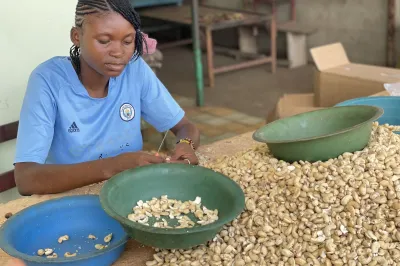Digital Finance in WAEMU: What’s New?
The journey toward financial inclusion in the West African Economic and Monetary Union (WAEMU) has made some interesting strides with digital financial services (DFS), even if the journey continues to be long.
According to the regional Central Bank (BCEAO), during the first nine months of 2015, DFS users made 346.9 million transactions worth $8.5 billion, increasing by 33% and 36%, respectively, compared to 2014. Last year, BCEAO updated its regulation for e-money issuance and distribution that will significantly influence the evolution of the DFS market in WAEMU moving forward.
However, let’s not lose sight of the fact that only 13% of the adult population in WAEMU has an account at a formal financial institution, and that when mobile money is added, the rate goes up to 18%. Despite its impressive growth, uptake of DFS across WAEMU has been relatively limited compared to its potential, and mobile money activity remains relatively low. For example, in Côte d’Ivoire, over 50% of registered clients report not having used their accounts within the past 90 days; in Senegal, while at least 80% of people are aware of mobile money, only 8% have used such a service.
Over the past several months, CGAP interviewed representatives of 100-plus organizations in Benin, Côte d’Ivoire, Senegal, Mali and Niger to better understand the market system for DFS in WAEMU. A new CGAP report provides an analysis of key actors in supply and demand, rules (e.g., regulations for e-money, telecommunications, competition) and supporting functions (e.g., agent networks, information providers). It also identifies root causes that explain why the DFS market is currently not serving the needs of low-income populations and opportunities for triggering systems-level change.
So what have we learned?

Regulatory environment. The 2006 regulation for e-money has been an enabling factor for the development of DFS, allowing banks and nonbanks to issue e-money. And so far, most mobile network operators (MNOs) have partnered with banks. With the updated 2015 e-money guidelines, the pathway for MNOs to create e-money-issuing subsidiaries is clearer, and some MNOs are embarking on that path. MNOs are expected to become more independent from banks and flexible in developing their mobile money offerings; as such, the partnerships are expected to focus more on developing second-generation DFS, such as credit, savings and insurance.
That said, some regulatory aspects remain unclear or incomplete, including know-your-customer (KYC) requirements, identification, agent banking regulation and access to the USSD channel. Some of these “gaps” are not just the domain of BCEAO; national telecom authorities, national identification offices and other national authorities are also involved. This will require further consultation and dialogue, as well as careful consideration of market specifics for each of the eight WAEMU countries.
Private sector. A key constraint identified by this study is that many banks, MFIs and even some MNOs are simply not convinced of the “business case” of growing their DFS offerings – they view it as too risky and not profitable enough. Distrust between MNOs and financial institutions (i.e., banks and microfinance institutions) is also impeding “deeper” partnerships that would offer DFS beyond cash-in/cash-out, person-to-person transfer and bill payments. While these are starting to develop in some of the more advanced WAEMU markets, it is still rare for financial institutions and MNOs to view each other as valued partners whom they trust and prioritize in their future growth strategies.
We hope that donors and policy makers, to some extent, will play a stronger role in encouraging providers to adopt a long-term approach to developing DFS as well as develop DFS channels and offerings suited for low-income customers.
Agent networks. Current agent networks without a doubt need to be expanded, both in number and location (in rural areas especially). However, this growth needs to be sustainable to ensure that agents remain active, provide good quality of service and are sufficiently liquid. That requires developing supporting infrastructure, such as telecom network coverage, and partnerships between MNOs and actors that can provide financial services to agents. It is also critical to provide training to help agents grow their businesses (and remain active) and monitoring to ensure their compliance with KYC and Anti-Money Laundering/Combating the Financing of Terrorism requirements.
Information. Up-to-date, publicly available information on both demand and supply of DFS in WAEMU is relatively limited, as is knowledge on what DFS offers have worked (or not) and why. A rapidly evolving market and an unwillingness by some actors to share data are at play. Limited resources and the capacity of actors to conduct, analyze and publish such research also contribute to this lack of information. Furthermore, even when such information is available, it may not always be widely communicated or presented in useful forms.
Some efforts are underway in a few countries to remedy to this challenge. Future information collection and knowledge-sharing initiatives should consider presentation and communication aspects as early on as possible, and as equally important to the actual content.
Political will. Lack of sufficient infrastructure and education in general are some of the most commonly cited constraints to greater DFS uptake. However, the root cause of many of these seems to be national political will and capacity to build the needed infrastructure (and to incentivize MNOs to deploy telecommunications infrastructure in rural areas), operate an educational system that ensures at least a minimum level of schooling and literacy of the entire population, and incentivize digital payments.
We hope to see national governments, in collaboration with BCEAO, prioritize these issues. The regional financial inclusion strategy developed by BCEAO offers a good framework for such efforts. Donors and development actors can support the implementation of this strategy through funding, technical assistance and encouragement to government partners to prioritize this work.
We need to push the boundaries for DFS to sustainably develop and continue to advance financial inclusion WAEMU. This report (in English and French) provides detailed information and analysis for market actors and donors to take on and work toward achieving this goal.




Add new comment